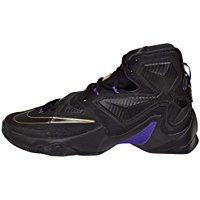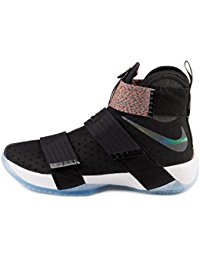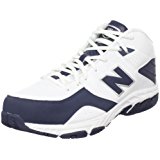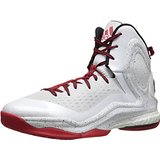Basketball Shoes for Knee Pain
A guest post today from Scott Johnson:
Basketball is a fast-paced and exciting sport that requires quickness and agility. It involves frequent stops, cutting side to side, pivoting and jumping; all of which make it a high-risk sport for knee injuries. For those with bad knees, reducing risk of these injuries becomes a priority.
As part of a plan to reduce knee injuries while playing basketball, it is important to properly move your knee, warm-up and cool-down, increase muscle strength and flexibility, and wear appropriate gear; including a suitable basketball shoe.
Pronation and Knees
When running or jumping, a normal and essential function of the foot called pronation occurs. Pronation refers to the action of the foot as it contacts the ground. During this process the tibia bone twists slightly inward causing the leg and knee to also rotate inward.
Abnormal pronation can create extra stress on the knee leading to pain; a very undesirable outcome for a person with bad knees. Overpronation, or excessive inward rotation, also negatively affects the knee joint and may lead to injury.
Shoe Selection for Knee Pain
When purchasing basketball shoes to reduce knee injury risk, both the amateur and the professional athlete must consider more than looks, comfort and fit. Having bad knees may increase your risk of injury when playing basketball. Knee injuries are often serious and difficult to recover from. Therefore, it is essential to consider shoe features that help support, stabilize and protect your knees.
Functions of Shoe Features
- To decrease impact and improve shock absorption, look for a shoe that is well cushioned. Your arch flattens during pronation to absorb and spread the impact of the shock to the foot and the knee, making ample shoe cushioning essential.
- A shoe with a firm heel supports and stabilizes the heel, as well as reduces overpronation, consequently reducing knee dysfunction. If your last pair of basketball shoes has excessive wear on the inside edge of the heal cushion, this may be an indication of overpronation.
- A firm midsole prevents excess flattening of the arch, reducing the shock felt through the knee because of impact. Additionally, a firm midsole reduces lateral knee movement and stress.
- A removable insole that allows a the use of either a high quality prefabricated orthotic or a custom orthotic
While the arch of the foot is made to flatten during contact, excessive flattening leads to over-pronation and excess twisting of the knee joint and attached ligaments. Below are some of the shoes that can be helpful for those with bad knees. But first, here’s an important disclosure about the products recommended in this article.
BASKETBALL SHOE RECOMMENDATIONS FOR BAD KNEES
Nike promotes the LeBron as a lightweight shoe with optimal cushioning and maximum support. Additionally, Nike says the shoe is designed to provide maximum protection during cuts and jumps. The Phylon® midsole is designed to provide a softer foot impact.
The Nike Soldier has heel and forefoot air cushion and a 3-strap system for secure and custom fit. It also has extra heel cushioning to absorb shock and a collar fit system for support.
With ABSORB® cushioning, New Balance 907 shoes provide excellent shock absorption. It also features an NB ZIP® heel cushioning that provides durable responsiveness. Another feature is the Heringbone Outsole that assists with quick pivoting by increasing lateral motion traction.
Offering superb support plus cushioning in the heel and the forefoot, the D Rose is a good choice for those with knee pain.
The AND1 Xcelerate has above average torsional stability so it helps to reduce pronation that can contribute to knee pain. It also has excellent cushioning. Another advantage is that they run a bit wide. Basketball shoes often run narrow so this wider fit can help a lot of people.
Benefits of Finding the Best Basketball Shoes for Knee Pain
The right basketball shoes can become the closest ally of a basketball player with bad knees. In fact, appropriate basketball shoes may have more effect on knee health than any other sports equipment. Ultimately, proper basketball shoes may be the difference between a experiencing and preventing a knee injury. The right basketball shoe will help your knee feel healthy and stable.
When Should Basketball Shoes be Replaced?
If you have knee pain then basketball shoes should be replaced regularly. Worn shoes no longer provide the support necessary for bad knees. Dr. Mike Lowe, the team podiatrist for the Utah Jazz, recommends replacing basketball shoes monthly to ensure maximum performance for those that play several times per week.
Orthotics for Knee Pain
In some situations foot orthotics can help reduce or eliminate knee pain. This is why is it critical that your basketball shoes have a removable insole and room to accept foot orthotics. You can learn more about orthotics for knee pain here.
References
- American Academy of Podiatric Sports Medicine: Overuse Knee Injuries: Evaluation and Management; Dr. William R. Olson aapsm.com
- University of Iowa Hospitals and Clinics: Pronated Foot;
- Foot Orthotics in Therapy and Sports; Skip Hunter, Michael G. Dolan, John M. Jarvis; 199
- American Academy of Podiatric Sports Medicine: Basketball Shoes and Injuries: aapsm.com
Resources
- Podiatry Care: How to Choose Basketball Shoes That Really Fit podcare.com
- Dick’s Sporting Goods: How to Buy Basketball Shoes
- Foot and Ankle Center of Washington: Shoe Recommendations
About the Author
Dr. Scott Johnson is Traditional Naturopath, Certified Professional Life Coach, powerful speaker and motivator. He earned a Doctor of Naturopathy, graduating with highest honors. He possesses a vast knowledge of herbs, dietary supplements, nutrition and health. He has used his knowledge to help others learn how to support the body’s own healing powers through natural means. He is the author of Nutrition A Word of Wisdom
The products links
- Do I Have to Keep Wearing My Orthotics if My Feet Feel Better? - November 29, 2019
- Flip Flops and Sandals for Ball of Foot Pain | Podiatrist Recommended - August 5, 2018
- How To Strengthen the Arch of Foot - August 31, 2017




